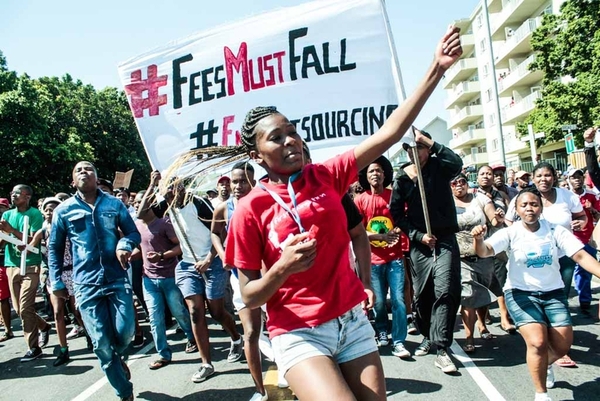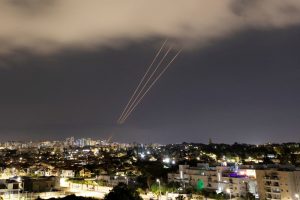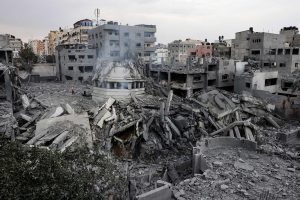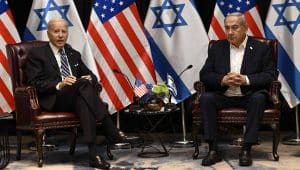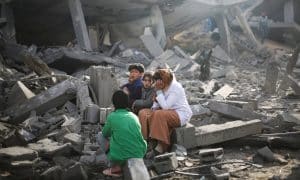A South African May ’68?
South Africa is currently faced with the largest movement of student unrest since the fall of apartheid. University students have begun an important struggle against big increases in university tuition, fees and room and board, ranging from 8% to 12%. The student protests that took place on October 14 at the University of Witwatersrand (Wits) in Johannesburg against a 10.6% rise in enrollment fees, as well as a 6% increase in application fees, were the spark that started a roaring fire of mobilization across the country. These actions culminated in national protests on October 21 with more than three thousand University of Cape Town students marching on Parliament. During the demonstration, in scenes reminiscent of the apartheid, the police launched stun grenades into the crowd in order to prevent students, who asked to be seen by the Minister of Higher Education Blade Nzimanade, secretary general of the Communist Party of South Africa, from entering the National Assembly. Several students were arrested: the charges of treason held against them had an incendiary effect on the movement, comparable to the accusations against the survivors of the slaughter of the Marikana miners with the assassination of their comrades under the apartheid-era common purpose doctrine. The following day, they were received as heroes by their comrades in struggle.
Subsequently, the largest demonstration took place last Friday in the Union Buildings, the official seat of the South African government and the office of South African President Jacob Zuma. More than ten thousand people gathered to demand that the proposed increase in university tuition be cancelled. The students demanded that Zuma come forward to face the consequences, but the government did not hesitate to send its repressive forces that used tear gas and rubber bullets against the demonstrators.
This is the single largest student protest since the Soweto uprising in 1976. The student’s combativeness forced Zuma’s government to back down. The president appeared before the demonstration to announce that tuition would not rise in 2016. However, in spite of this retreat, several universities stayed mobilized on Monday. As they themselves affirmed, “Phase 2 is now to obtain the reduction of university fees. Enrollment is still the same price. There is nothing to celebrate.” Another student added, “We are not only fighting against the increase in tuition. We are fighting any and all increases that have taken place since 2011, including for individual modules.” This demand is not secondary in a country where enrollment fees vary according to the university, but can be as high as 60,000 rands ($4,400 US) for medical students, and where White families earn as much as six times more than Black families according to official numbers. All of this in a context of low economic growth since 2009 because of the recession and the government’s austerity policies that have progressively reduced the budget for public student aid.
Racial Inequality Behind Students’ Demands
Student discontent has not fallen like lightning from heaven. It is the coronation of years of protest and frustration, centered in majority-Black universities.
In 1996, the ANC announced its GEAR policy (Growth, Employment and Redistribution), which aimed to promote economic orthodoxy (liberalizing and opening the country up to international capital after a semi self-sufficient period as a consequence of international sanctions against “apartheid”), to fight poverty and racial inequality, and develop affirmative action programs like the racial quotas in businesses of a certain size. This brought about the fusion of historically-Black universities with historically-White universities. In reality, the universities whose student body was for the better part Black continued to function with very little resources, a kind of university Bantustan, and until very recently formed the focal point of student protest.
The difference with the current movement is that historically-White universities have joined the cause. Both Black and White students have united against the increases in tuition, the hashtag #FeesMustFall became a rally cry against the hikes. Black protesters from Eastcape Midlands College were targeted by police and requested White students form a human shield around them. In a demonstration of solidarity, White students from Rhodes University came to their aid, putting themselves on the front line in the hopes that the South African state would be less willing to brutalize White students than Black students. This gesture of solidarity was also an acknowledgement of the racist and repressive nature of the South African State.
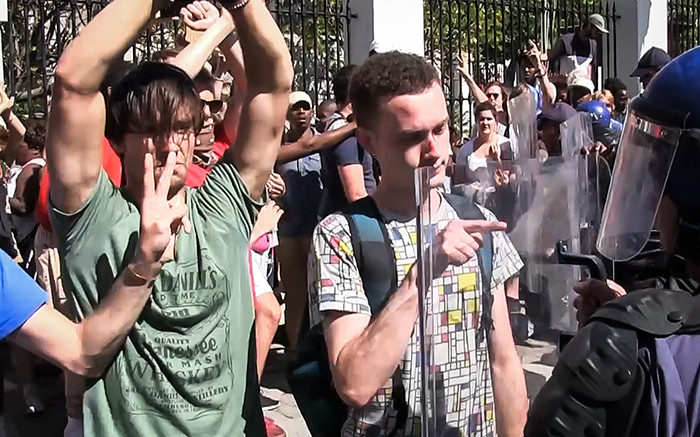
These ancient bastions of White privilege have experienced a growing influence of mainly middle-class Black students – the sons and daughters of the new Black middle class that developed during the raw materials boom from the end of the 1990s to the mid-2000s. Although White students still form the majority at the University of Stellenbosch – the academic seat of Afrikaner nationalism, with courses still taught in Afrikaans – Black students make up 70% of the student body of formerly White-dominated universities. But this movement is far from solving the problem of racial inequality, even if it has exposed the problem more clearly. As one student stated in the New York Times, “It was only when he landed at the University of Cape Town, a bastion of the fight against apartheid, that Rambina Mahapa became truly conscious of his race. Mr. Mahapa, 23, grew up in a village with only black South Africans, and he graduated at the top of his high school class. But when he got to the University of Cape Town, the gap between Black and White students became clear to him: Of the 15 people who owned cars in his dorm, only one was black. When the first test results came in, the Black students ranked at the bottom. ‘That’s why I then started feeling black,’ said Mr. Mahapa, who was born two years before the end of apartheid and is now a third-year psychology and philosophy major, as well as the president of the university’s student government. ‘Even when I occasionally would see pictures on TV about apartheid, you never internalized it or thought about it – up until you come to a space where you actually experience it’.”
Students, a Sounding Board for the Social Frustration of All Layers of the Population of a Post-Apartheid Regime
The current wave of university protests is a new turning point in the dynamic of class struggle that began with the Marikana massacre. It shows us that middle layers of the population such as students are fed up with high tuition fees; with their living conditions; with their poor employment perspectives after graduation; and with public money that is wasted because of the brutal corruption of the new post-apartheid black political elite which Jacob Zuma is one of the most pathetic incarnations.
Historically, the student movement in South Africa has played a pivotal role in general discontent as was the case in 1960, 1976 and 1985. The enormous support and the enormous sympathy, not only passive, but sometimes very active, that its determination to fight until the very end awakens in the population shows us this. The Times reported on October 23 that a mother in Cape Town, after learning that her son was involved in a clash with police at the Free State University, packed a trailer full of food, kitchen utensils and packets of soup and went to support him. Members of the community have allied themselves with the students, bringing them food and water. The owner of a water supply company organized a convoy to deliver water to students. In Pretoria, a pizzeria supplied five hundred pizzas for the protesting students.
What began and continues to be a protest against university tuition fees has quickly become a wider protest against inequality, against the monopoly of the country’s resources by a privileged minority while the majority lives in poverty.
The growing discontent of poverty-stricken persons has taken different forms of mobilization and protest, earning South Africa the title of “world capital of protest,” with an average of 35 protests per day. They have organized themselves to protest against their terrible living conditions, lack of adequate housing, security, electricity, water, and proper sanitation. Despite the fact that South Africa is a country of average income, as many as one in four persons living in South Africa go hungry every night. Families continue to fight to stay alive as the economy continues to fall and unemployment rises, especially among the youth. Alongside the poorest segments of the population are workers who have been resisting the attacks of imperialist multinationals and the government, like the Marikana miners facing Anglo-American or workers in the automotive sector who recently faced off with their employer.
End of the “Rainbow Nation” Illusion
The backdrop of the student uprising is the worst economic crisis since the end of apartheid. Of the millions of jobs lost since the world crisis of 2007/2008, none have been recuperated. After a 1.3% contraction in the second trimester, the economy may have entered its second recession in only five years. In this context, the coalition composed of the ANC, the South African Communist Party and the COSATU (Congress of South African Trade Unions) that brought Zuma to power is now in ruins. It finds itself divided after the exclusion of its main affiliate, the metallurgic trade union (NUMSA) with 320 thousand members after its decision to break with the tripartite alliance and its announced plans to launch a united front, a movement for a new workers’ socialist party.
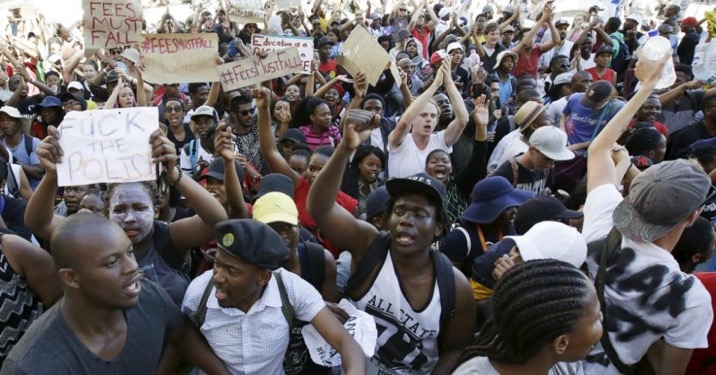
The student protests have hit the government and the ivory tower hard 21 years after the ANC, led by Mandela, began the transition to a multiracial parliamentary republic, which in exchange for a few concessions ensured the white bourgeoisie’s survival and its economic and political dominance. Today, certain segments of the population have become aware of this fraud: “The majority of South Africans have been very naive, pushing the ‘Rainbow nation’, or however they call it,” claims Majaletje Mathume, a student activist at the University of Stellenbosch, “To a large extent, many Black South Africans still feel as if they are in the service of white people. The transition was based on not hurting their feelings, not wanting them to feel.”
In other words, the student actions have revealed a broader, nation-wide dissatisfaction with the policy of equal representation for Blacks. Because in contemporary South Africa, as a product of the transition pact between the ANC and the apartheid government in 1994, Whites retain a disproportionate power over the economy and other important sectors such as higher education. The reality is that the transitions or transformation has benefited only a small Black elite with political relations, while the majority of the population has benefited very little. The latter begin to awaken politically. “During the protests there were many people who questioned and condemned the 1994 project,” explains Rekgotsofetse Chikane, 24, another student leader at the University of Cape Town who added that criticism went as far as including former President Nelson Mandela. “And if Mandela was not safe (from criticism), no leader can be.”
The South African student movement’s awakening and leap forward in terms of political consciousness is a rallying cry for the oppressed and exploited of the world.


